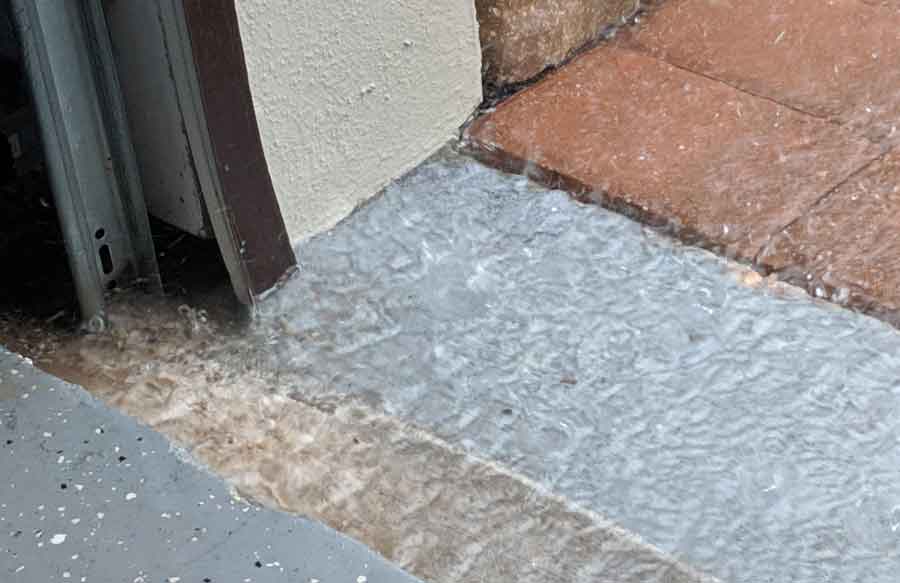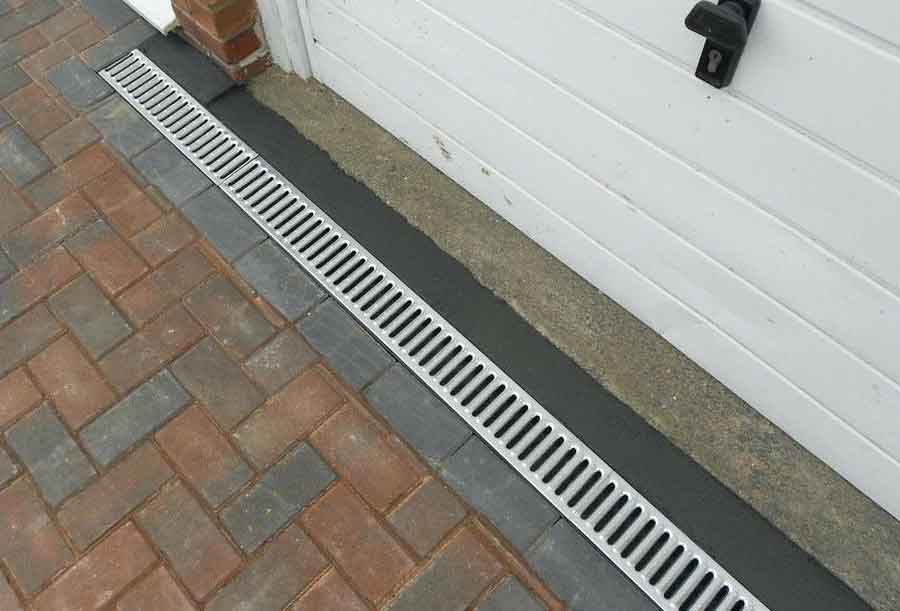If your house is like mine, it’s common to get puddles of water pooling on your garage floor.
In my garage, that puddle is always in the front right corner, and it drives me CRAZY.
Like most homes, mine is sloped to direct all the water to the corners. However, there was supposed to be a drainage outlet to help it flow outside.
There isn’t.

Now I’m on a mission to get as much water out of my garage as possible.
I started digging into where the water came from and some ways to stop it.
Assuming you don’t have flood damage or a leaky hot tub in your garage, water accumulates in two ways: dripping off your car or excess rainwater from under your garage door. Thankfully, that makes it relatively easy to keep water out of a garage.
I’ll talk about each of those situations separately. Then we’ll cover what you can do to minimize or eliminate excess water in your garage.
If water is coming in through your concrete walls, check out my article showing how to waterproof garage walls to stop water from leaking.
Why Does My Garage Door Leak?
There are several reasons why water gets into your garage.
Almost all of them have water coming in through that big gaping hole you drive your car through.
So why does a garage door leak? It depends on where the leak is coming from. Leaks around the door’s sides usually mean a seal is damaged or missing. Awnings or sills stop water from getting behind the door, so if you see leaking at the top of the door, that’s usually the culprit. Water coming into a garage through the bottom of the door usually involves gaps between the concrete floor and the garage door.
The most common place where your garage door leaks is on the floor, where the door meets the concrete.
Let’s look at some ways to fix those leaks: a threshold seal and a trench drain.
What is a Garage Door Threshold Seal?
Over time, concrete floors shift and settle, creating gaps where the garage door doesn’t fit properly.
If there are gaps, it’s like a flashing neon sign pointing into your garage. That’s where a garage threshold seal can help.
A garage threshold seal is a piece of hard rubber, plastic, or aluminum that sticks on the concrete right where the door meets the concrete garage floor – almost like a small speed bump. It creates a tighter seal by eliminating gaps, which helps regulate the temperature inside your garage and keeps bugs, dust, and rainwater outside where they belong.
Why do you need one?

I said in the beginning that my concrete floor wasn’t exactly level. Although garage floors are supposed to slope slightly, my garage floor looked like it had waves. There was about an inch gap between the bottom of the garage door’s rubber seal and the concrete floor. However, that gap varied across the width of the door.
That’s big enough for cockroaches or even small rodents to get through.
Just imagine how much water could seep in.
A threshold seal eliminates that gap by adding a barrier underneath and behind the garage door seal.
Seals are reasonably inexpensive (under $100) and can easily be installed in under an hour.
Do You Need a Trench Drain to Keep Water Out of a Garage?
Adding seals around the door won’t fix the problem if your driveway slopes into your garage.
The water will run down the slope straight into your garage.
A trench drain (channel drain or French drain) right outside the garage door fixes that. It catches the water running down the slope and then ‘channels’ it away from the door to someplace with adequate drainage.

Imagine a long U-shaped tub made of metal or plastic that’s open on top. Cover that opening with a metal grate to keep out any leaves and debris.
One or both of the open ends need to be attached to drainage pipes, so the water can drain out.
Trench drains are harder to install than some of the other solutions here.
You’ll need to pull up the pavers or jackhammer your driveway to make room. Once the drain is in, you must add new concrete to keep it in place.
I’d skip a trench drain unless you’ve got a badly sloped driveway that causes lots of direct water runoff into your garage.
Should You Put a Wet Car in the Garage?
The car’s finish is designed to withstand extremes, so I wouldn’t worry about the water damaging the paint beyond unsightly water spots.
The dirty, salty slush you’ve got in the Northeast is a different story.
Unless you hate your car, it’s best to clean that off before it damages your paint and the snow melts all over your garage floor.
That doesn’t mean you’re all clear, though. There’s not much airflow in your garage, so we need alternative ways to keep your garage cool.
No airflow means the water on your car can find its way into the cracks, and in between, the panels of your car can’t properly evaporate. If the seals are old and damaged, that water may seep into more critical areas.
That excess water also adds to the overall humidity level in the garage. There’s a story that placing a bowl of water in a perfectly sealed room will increase the humidity level to 100%. It turns out that’s true.
This is especially problematic if you live in the hot and humid South.
High humidity can also cause electrical problems – not just for your car but for your cordless tools, fans, and anything else with wiring that’s not sealed well.
So should you put a wet car in the garage? No. Always attempt to dry your car off once you park it for the night.
How Do I Dry Out My Garage?
Eventually, you’ll have puddles of water in your garage that you need to get rid of.
At best, rainwater will be dripping from your car or blowing in from the outside. Worst case, it could be a drainage problem or a flood. Dealing with a flooded garage is beyond the scope of this article, but for smaller leaks, let’s talk about a few quick ways to dry out your garage.
Squeegee out the excess water: Don’t let that water pool. The longer water sits, the more damage it will do – especially if it can seep into your walls or drywall.
Run a dehumidifier: A garage dehumidifier will take the water out of the air. It’s a slow process that uses a lot of energy, so don’t rely on this too much unless you’re a stockholder in your local electric company.
Use a fan to get more air circulation: The more airflow you have, the faster your garage will dry out. I have a wall-mounted Air King fan in my garage, and I love it!
Towels and mops: The low-tech method of drying out your garage isn’t necessarily a bad one. If your leak is bad enough, put towels between the water and anything sensitive. Try to mop up any excess water before it has time to spread.
Wrapping It Up
While dealing with my water problems, I’ve discovered that it’s not just rainwater or snowmelt from your car that contributes to the issue. Leaks around your garage door play a significant role too.
However, solutions like threshold seals and trench drains can keep water out of a garage.
A threshold seal can prevent rainwater, bugs, and dust from entering your garage by sealing the gap between your garage door and the concrete floor.
On the other hand, a trench drain, though slightly difficult to install, can redirect and keep water out of a garage, especially if your driveway slopes towards it. We recommend installing drains if you have a lot of water coming off your garage roof in front of your garage doors.
We’ve also learned that it’s better to dry your car before storing it in the garage to avoid contributing to humidity. Increased humidity can lead to electrical issues.
If your garage ends up getting wet, you have various options:
- Use a garage floor squeegee to remove excess water.
- Using a dehumidifier or fan to dry the air.
- Mopping up with towels.
Keeping your garage dry is crucial for the longevity of your car and other stored items. So, take control today and bid farewell to those irritating water puddles.

